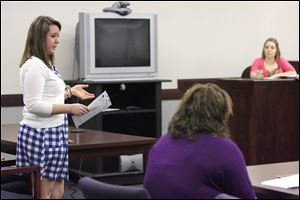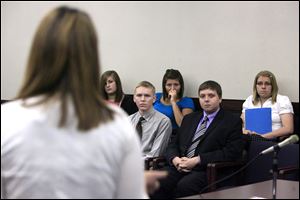
At Teen Court, peers dish out judgment, justice to offenders
4/18/2010
Jessica Walls, left, of Otsego High School acts as defense attorney while Heather Booth of Eastwood High School, foreground, serves as prosecutor during a session of the Teen Court program. Looking on is Christy Snyder, director of youth services.
The Blade/Andy Morrison
Buy This Image

Jessica Walls, left, of Otsego High School acts as defense attorney while Heather Booth of Eastwood High School, foreground, serves as prosecutor during a session of the Teen Court program. Looking on is Christy Snyder, director of youth services.
BOWLING GREEN - A 15-year-old caught shoplifting a bottle of makeup sat nervously before a jury of her peers.
The jury foreman, Rossford High School sophomore Jordan Bauer, read the girl's sentence: six hours of community service, a tour of the Wood County Juvenile Detention Center, a face-to-face apology to her parents, and a written apology to the store and to her younger sister, who was with her when she stole a $6 bottle of foundation and stashed it in her purse. "We see you're a really good student," Jordan told the offender. "We want you to be a leader and not a follower."
One Wednesday evening a month, eight high school students from across Wood County gather at Juvenile Court to administer justice to their peers.They act as prosecutor, defense attorney, and jury in cases where the offender has admitted his or her crime.
Students administer justice to their peers in Teen Court
The unusual new program allows qualified juveniles who are first-time, nonviolent offenders to have their sentence decided by the Teen Court rather than a magistrate or judge. If they complete all that is required of them, the charge is dismissed and their court record sealed.
It's not a mock trial, but the real thing - as members of the Teen Court quickly learned.
"You get in here and it feels like acting and then the person walks in and that changes everything - especially when you're in the jury and they look over at you," said Jane Powell, a junior at North Baltimore High School.
John Vrzal, a sophomore at Perrysburg High School, said the experience has been very real for him.
"I've seen other programs like mock trials and it's nice to know this is a real case. I'm actually affecting a person's life," he said. "It definitely puts things in perspective. I certainly do not want to be in this situation."

Jessica Walls, foreground, addresses a Teen Court jury that includes, front from left, Chris Woessner of Bowling Green High School and John Vrzal of Perrysburg High School and, back from left, Jessica McKenzie of Elmwood High School, Bre Hitchen of Lake High School, and Jane Powell of North Baltimore High School.
While John and some other Teen Court members said they are interested in careers in law, giving them experience in a courtroom is not the primary objective.
Wood County Prosecutor Paul Dobson, whose office runs the Teen Court, said the program was launched in January to alter the behavior of juvenile offenders in a positive way and reduce recidivism.
"I think the research has shown - and I think to some degree it is borne out in common sense - the impact of kids being told by their own peers, 'We don't even like what you did. Here's where you went wrong and here's how you should account for it or get some help to adjust that,'•" he said.
That is the philosophy behind the 1,100-plus youth courts that were in operation across the country by 2006, according to the National Youth Court Database. Some are operated at schools or community organizations, while others are court-based.
Mr. Dobson said Wood County, which has the only Teen Court in northwest Ohio, modeled its program on Stark County's in northeast Ohio, which has operated a youth court for nearly 15 years.
Allison Sarris, teen court coordinator for Stark County Family Court, said the court meets three times a week during the school year. Youths who go through the program reoffend at a rate of about 15 percent, she said.
"We believe it's effective because they're dealing with a group of peers and not having a judge in a black robe telling them, 'Here's what you're going to do,'•" Ms. Sarris said. "And it helps that teens know and understand what's going on in their lives. They're out in the schools. They're in jobs with them."
At a session in Wood County Juvenile Court last week, Tim Atkins, chief assistant prosecutor in the juvenile division, acted as hearing officer for the proceedings, which began with both the teen prosecutor and defense attorney reciting their version of the crime along with recommendations for sentencing.
The jury was permitted to ask questions, and the juvenile whose case was being heard had the opportunity to speak. The parents of the accused also were allowed to address the court before the jury began its deliberations.
"We're not here to relitigate the case," Mr. Atkins said. "We're here to have them say, 'Here's what they did. Here's what we think should happen.'"
One teenage girl who admitted to a charge of disorderly conduct stemming from a fight at school promised not to repeat her mistake.
The fight erupted after another girl took over the cafeteria table she had sat at every day.
"It could have been avoided. I don't think there was any need for violence," the young offender told the Teen Court.
"I could've sat at another table. The whole thing happened very quick. I didn't know what else to do, and once she hit me, I felt like I had to hit her."
Among other things, the jury told her she must attend an anger-management class and write a letter of apology to her principal and mother.
Since January, Wood County's Teen Court has heard 11 cases.
Christy Snyder, director of youth services and programs for the prosecutor's office, said four of the juveniles who went through Teen Court have completed their sentences. "So far, none have reoffended," Ms. Snyder said. "They are taking it very seriously."
If they do reoffend or fail to complete their sentences, their cases will wind up before Juvenile Court Judge Dave Woessner. The judge, who reviews the Teen Court's sentencing orders but does not attend the hearings, said he's been impressed with the new program.
"The dispositions I've seen so far are interesting," Judge Woessner said. "They've ordered or recommended youth make a face-to-face apology with their parents or ordered them to write a real specific type of paper rather than a simple letter of apology… It's a unique program."
Contact Jennifer Feehan at:
jfeehan@theblade.com
or 419-724-6129.